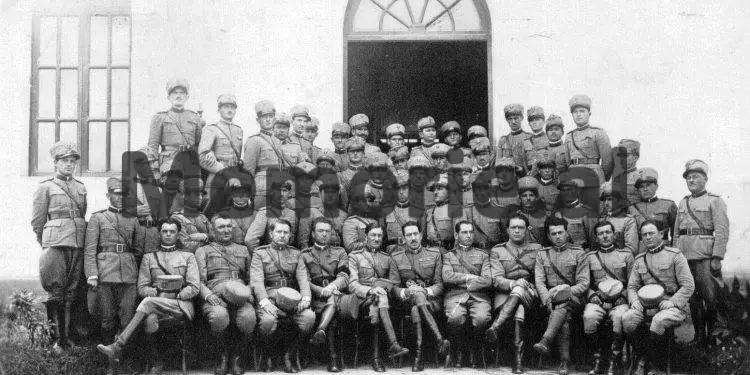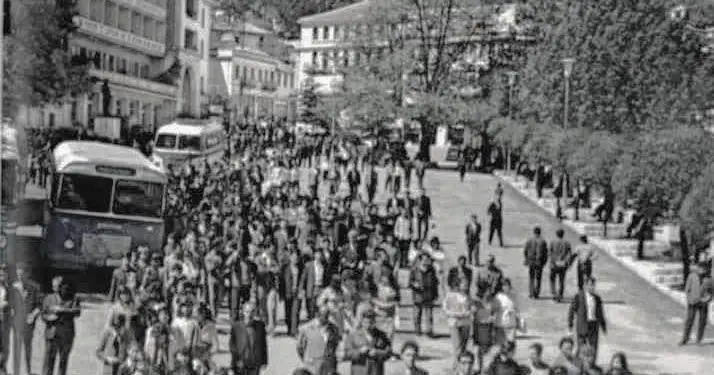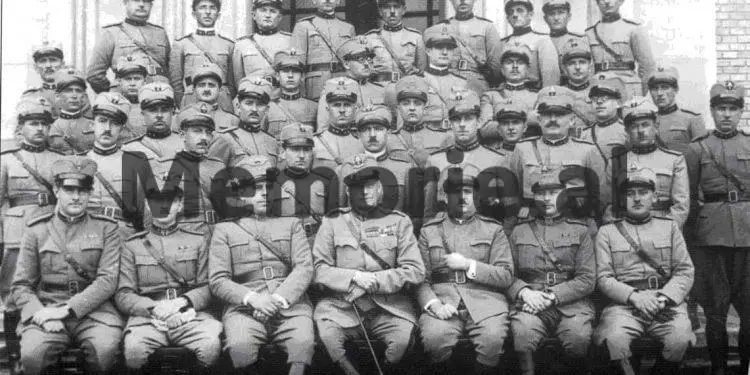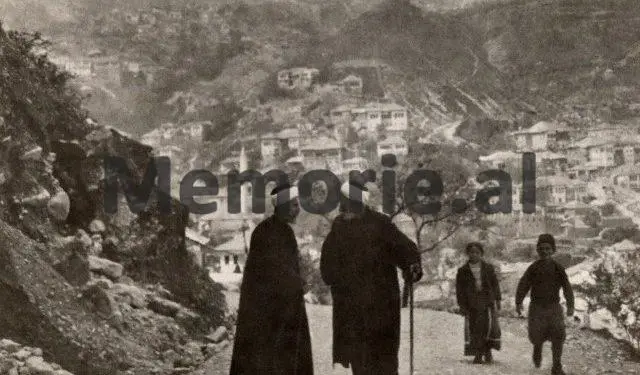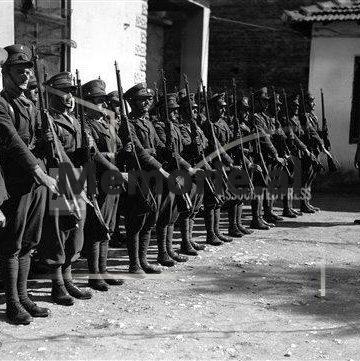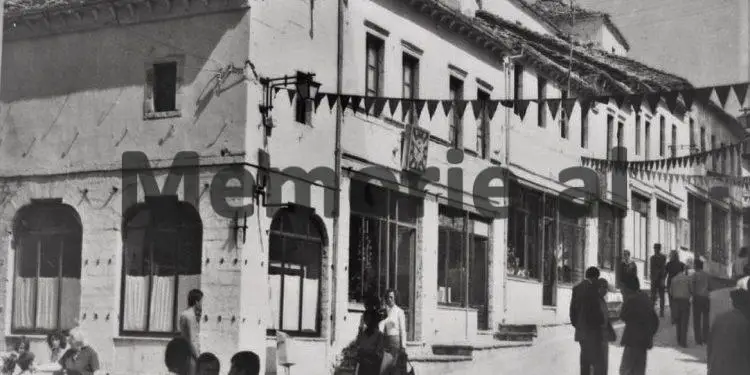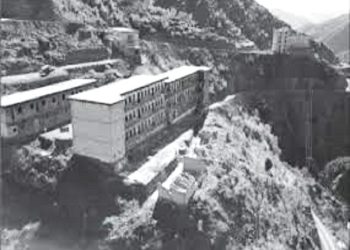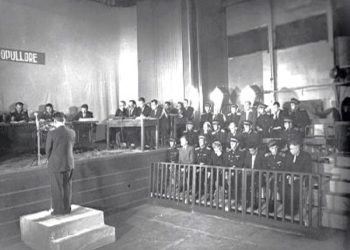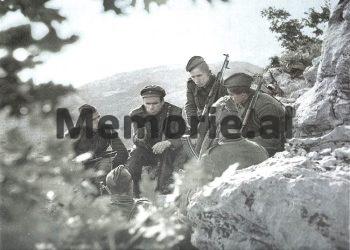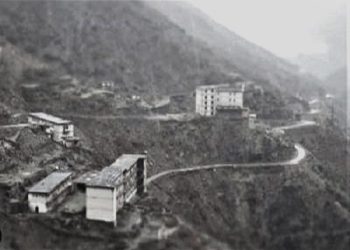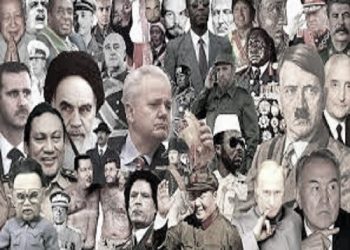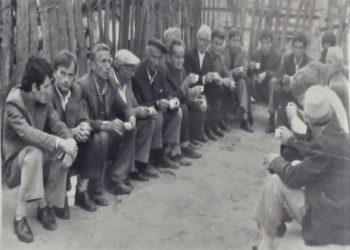Prof. Assoc. Dr. Zaho GOLEMI
Memorie.al / A poet from Gjirokastra define the stone city in the limits of human love: “If you said Gjirokastra, you said it all”. Researching documents from the beginning of the last century, it turns out that Gjirokastra, the aristocratic city, had a thirst for knowledge, education and culture, but also for order, peace and public safety. Thus, it turns out that the first Gendarmerie school, with police functions in Albania, was opened in early 1919 in Gjirokastra. This is also documented through photos found in Gjirokastra by the well-known Gjirokastra collector, Girando Koti and the Honorary Consul of Italy in Gjirokastra, Teodor Bilushi.
In Sejfi Vllamasi’s “Political Encounters”, it is the year 1916 when the Italian authorities created the Gjirokastra Militia with two regiments with three battalions each, a force of 2800 men, under the command of General Ferrero. Each militia unit was led by an Italian major and an Albanian sub-commander, where the Albanians were Kasëm Radovicka, Riza Cerova, Captain Zef Pali, and Captain Halo Kuçi. In almost two years, the Albanian officers and non-commissioned officers were trained in Italy and were included in the Albanian militia in Gjirokastra and its occupation zone, where out of 45 officers; nine of them were academic officers.
All the organizations of the Albanian Gendarmerie and militia in this period were related to the Order of the High Command of the Italian Forces in the Balkans, which bears the date 19.1.1919, which entered into force as a decree-order on 15.2.1919. This also included the spectrum of joint Italian-Albanian courses and trainings. Documentary and photographic contributions from Gjirokastra, Shkodra, Vlora, Korça, Burreli, AQSH, AQSHF, etc., are valuable for the foundations of Gendarmerie and police education at the beginning of the last century.
Data on the first Gendarmerie School are also documented through the first photo in the Gjirokastra castle, for the first 120 trainees led by Italian Carabinieri instructors, but also Albanians, an experience of the most advanced schools in the West. The first students of the Gendarmerie School were mainly from the surrounding villages, but also from Delvina, Tepelena and Përmeti.
In Gjirokastër, the activity of the Gendarmerie School is also documented since the spring of 1919, a school that opened before other schools in Albania. On the other hand, it is an interesting fact that even the “Çerçiz Topulli” square, at the foot of the castle, before taking on this great name in Albanian history, was called: “The Gendarmerie Square”. This was the historical and most important square of the city of Gjirokastra, after the preparation by Odhise Paskali (the Italian sculptor Givera and the Viennese sculptor Bildshauer Perseshuer were also contacted) and the installation of the Çerçiz Topulli monument in 1934, while the naming of the square “Çerçiz Topulli” was done after the War of Vlora, in June 1922.
(The monument that cost 3600 gold francs was erected with the contribution of the people of Gjirokastra under the direction of the mayor, Sami Kokalari, and was inaugurated on 18.3.1934). The “Xhandarmëria” (Police) Square was named “Çerçiz Topulli” Square in June 1922, at the initiative of Veli Hashorva and Javer Hurshit. The idea for the bust was proposed by the Albanian-American journalist, Xhevat Kallajxhi, when he visited the amazing Italian statues in 1927. (Nebil Çika’s “Minerva” magazine, 15.5.1934).
The newspaper “Demokratia” also played a role, as did Beso Gega, Galip Çano, Xhevat Kallajxhi, Vasil Lito, Aleks Çeçi, Xhevdet Xheneti, Sami Kokalari, Foto Tola, Elmaz Hajdëri and Bame Mezini. The tent was shot by an Italian soldier during the Italian occupation during World War II. Near the municipality, the 2.6 m. high bronze statue of Çerçiz, in the former Gendarmerie Square, the famous bar “Shqipja” operated, which would later be named “Bela Venecia”.
But beyond the labels of the gendarmerie, the name of the martyr and hero of the nation, Çerçiz Topulli would become honor, pride and the most famous part of the city of Gjirokastra, along with the castle, the cobblestones and the famous houses of the stone city. “The city and the silver castle, it seems to have emerged from the mountain and a labyrinthine extension of the mountain”, or as Dervish Mehmet Zilli (Evlia Çelebi 25.3.1611-1682) called it in 1672: “The castle of Gjirokastra, is an unparalleled castle”. The object of this writing is precisely the beginnings of the education of the Gendarmerie and the training of gendarmerie troops, as well as those of the gendarmerie with police functions.
Although during the Ottoman occupation, both the police and the gendarmerie existed in Albania, with separate tasks and meeting points between them. By decision of the Provisional Government of Vid, in the meeting dated 13.1.1913 written in Ottoman in point I. It is written; “it is necessary to carry out a reform in matters of finance and in those of public peace” and in point II; “Organization of the gendarmerie and salaries”… “..this organization will be implemented on 1.2.1328/14.2.1913”. (AQSH, Fund 254/II, 1912, File 69/1 original in Ottoman and translation into Albanian).
After the Gendarmerie School of Gjirokastra, also as a need and necessity of the time, the attention of the Albanian intellectual elite, and especially after the Congress of Lushnja and the Battle of Vlora, re-established Albanian institutions, which from a historical perspective, we can also call the second independence of Albania. Although there is little documentary and photographic data, it is still known that on the Gjirokastra soil, a place that is thirsty for education, culture and knowledge, the Gendarmerie School was founded that prepared, trained and fully formed a well-known gendarmerie corps, despite the limitations of the time under occupation.
The cadets had a corps of instructors from the Italian Carabinieri, as well as Albanian officers who had completed their studies in Turkey or in Western schools. The cadets were regional arrivals from Gjirokastra, Libohova, Delvina, Tepelena and Përmet. The selection was especially for physical parameters.
Despite the fact that the duration of the first Gendarmerie school with police functions was not very long, it is one of the cornerstones of the education of the Gendarmerie and the police in Albania. The Gjirokastra Gendarmerie School was followed by the opening of the Vlora Gendarmerie School and then by the Tirana Gendarmerie School opened on 5.6.1919. The Tirana School was led by Major Ali Shefqeti and then by Major Ismail Haki Kuçi.
The first attempts at police education, peace and public order, primary
In the Balkan Wars and World War I, Albania had become a battlefield, where over 250 thousand soldiers of seven armies stepped foot: Italian, Austro-Hungarian, French, Bulgarian, Greek, Montenegrin and Serbian. The first structure that, during the government of Ismail Qemali, performed the functions of guard, gendarmerie and police, but also of the Guard, were 400 Albanian fighters who came from Kosovo. It is no coincidence that Ismail Qemali asked Isa Boletini, two loyal sons from the Kosovo Albanians who had accompanied him to Vlora, to act as guards at the door of the newly formed government office.
The fact is that he had never thought that with that action, he was unwittingly sanctioning the foundations of the future Gendarmerie of the Albanian state, the police functions but also of the Albanian Guard of the protection and protection of state personalities. Thus, Isa Boletini, while ordering those two young boys from Kosovo, named Ahmet Llapi (from the Llapi area) and Halim Bajgora (from Podujeva), to protect the first prime minister of the newly created government, also had never thought that he had given himself the attributes of the Commander of the Guard, in the first government of the Albanian state.
The fact is that six weeks after the independence of November 28, 1912, was declared by the Assembly of Vlora, on January 13, 1913, the government of Ismail Qemal bey Vlora, decided to create the forces of order. The message of the father of Independence, for the state that was being established for the first time for Albanians, was precisely about maintaining order, peace: “Try to ensure the peace of the country and public order as best you can…” (AQSH, Documentary Funds, Year 1912, File 1, Document no. 723/19 dated 28.11.1912). The Provisional Government of Vlora issued the Decision for the Creation of the Order Forces, which consisted of the Police Force and the Gendarmerie Force (AQSH. Documentary Fund no. 245/II, file 69, page 1).
For the first time in an Albanian government, the Public Security Office began to function, which if translated was the “Albanian Police Directorate”. Archival records show that the Government assigned the tasks of organizing the gendarmerie to Alem Tragjasi, Hysni Toska, Sali Vranishti and Hajredin Hekalin, while the administrative functions were carried out by the police. The first director of the police was appointed Halim Bey Gostivar.
In June 1913, the Gendarmerie took functional form, after three battalions were formed led by Major Hysen Prishtina in Vlora, Captain Ali Tetova in Berat and Major Ismail Haki Tatzati in Elbasan. On 3.6.1913, the regulation of the Government of Vlora was implemented; “on the formation of the Albanian Militia”, written in the Ottoman language and translated into Albanian.
The Vlora government on 20.12.1913 issued the temporary decree “on the creation of the southern gendarmerie”, where the Dutch mission of Colonel William I. H. De Weer, who arrived in November 1913, contributed to the formation of four gendarmerie units, with three hundred people each. In March 1914, several more Dutch officers arrived, who dispersed 4 previously created detachments. The Dutch officers were charged by the Great Powers with the organization of the Albanian armed forces.
With the relocation of the capital from Vlora to the city of Durrës, Veli Vasjari came to the head of the police. Based on the organic statute of 10 April 1914, or the first constitution of the country, chapter IX, of the Organic Status of Albania, the Armed Forces included the Gendarmerie and the Militia. The militia was a “local territorial and sedentary military force” and in peacetime supported the actions of the gendarmerie. The origins of the creation of the Gendarmerie education, which began in the Gjirokastra castle, date back to immediately after the end of World War I, around mid-February 1919. It was the time when the General Commander of the Gendarmerie and its organizer was Colonel Ridolfi and his assistant, Major Banush Hamdi.
But the first tendencies of education can be found in Shkodër in 1916, with the support of the Austro-Hungarian command in Albania, which selected approximately 40 boys, who were sent to the military schools of Austria. (“Albania in 1937”, State Action during the First Twenty-Five Years of Self-Government Volume I (1912-1937), Tirana, 1938, page 89). On 10.12.1916, the “French” Republic of Korça was established, led by Themistokli Germenji and the French captain Henri Descoins, the police prefecture and police offices were established.
After the end of World War I, on 25.12.1918, the government established in Durrës, under the command of Major Ismail Haki Tatzati, the Italian organizer Ridolfo, and Major Banush Hamdiu, formed a gendarmerie force and a year later a school for aspirants and gendarmes was opened in Tirana, on 5.6.1919 with Commander Ali Shefqeti and later Haki Kuçi. In August 1919, gendarmerie battalions were formed in the centers of the prefectures. After the Congress of Lushnja and the formation of the Tirana government of Sulejman Delvina, the reorganization of the law enforcement forces took place.
The dependence of the gendarmerie according to the regulations was indirectly from the Ministry of Internal Affairs, for peace, and from the Ministry of Justice, for the implementation of court decisions. The administrative territorial division was organically made into a district (in each prefecture), a district (in each sub-prefecture), a post-command (in each province or village). The Gendarmerie was divided into 9 district-commands, 40 district-commands and many post-commands.
The state apparatus, after 1925, was reorganized and the Gendarmerie was divided into 4 zone-commands centered in Tirana, Shkodër, Peshkopi, Saranda, which were commanded by captains Preng Previzi, Fiqri Dine, Muharrem Bajraktari and Hysni Dema. But in addition to the gendarmerie, on 22.12.1925, the police was also created as a special structure, which had its offices in Tirana, Berat, Elbasan, Korçë, Vlorë, Gjirokastër, Shkodër and Durrës. The police had investigative and administrative functions and was subordinate to the prefect. This continued throughout the entire period of the First Albanian Republic, i.e. in the years 1925-1928.
During the years of the kingdom, the Gendarmerie and Police had its own specifics, since based on the law of 18.5.1933, the Royal Gendarmerie Arm was divided into the General Command, the Command of the Gendarmerie School, 10 district commands, 31 district commands, 253 post commands. From a military point of view, it was subordinate to the General Command. Public order and peace depended on the Ministry of Internal Affairs, while the judicial police service was subordinate to the Ministry of Justice. The police, which was created on 22.12.1925 with eight offices in the main cities, functioned until 1935, when the “Pandeli Evangeli” government, by decree law of 25 June 1935, dissolved the police and replaced it with the urban gendarmerie, under the orders of the prefects, sub-prefects and mayors of the communes.
The fact is that based on official documents, the Gendarmerie Command in December 1927, in Albania had: 112 gendarmerie officers, 562 gendarmerie non-commissioned officers, 2441 gendarmes, 39 district commanders, 3000 Austrian weapons. Also in 1927, Colonel Alberto Pariani was appointed military attaché in Tirana, at the head of a large military mission with about 200 Italian soldiers, which dealt with the reorganization of the Albanian army, undoubtedly taking as a model the Italian royal army, with a partially fortified system with 60 km. border line, to be able to delay the enemy, to give time to the Italian troops to land in Albania.
In 1933, at the head of the Gendarmerie was Lieutenant Colonel Shefki Shatku, who was one of the most prepared officers of that weapon. In assistance to the Gendarmerie, the English General Jocelyn Percy, (who replaced Colonel Frank W. Stering, who had come to Durrës, in May 1923) who contributed to the strengthening and consolidation of that weapon. In the summer of 1937, the project for the formation of the World Security Police was launched and the first test included 275 police officers, all aged 23-33, with a special police school. It was to replace the gendarmerie of the cities of Tirana, Shkodër, Durrës, Korçë, Vlorë and Saranda. This structure was subordinate to the Ministry of Internal Affairs and in 1938; the Albanian Gendarmerie had 3643 employees.
While the law approved on 19.1.1938 could not be tested, due to the fascist invasion of Albania on 7 April 1939. The first police course established on 21 May 1938 with Commander Major Viktor Shantoja, did not have the opportunity to be tested because after a year all the students of this course continued their studies in Italy. In the decades that followed and especially after the Second World War, the dimensions of the police education system had a dictated path, where the routine and daily life of the problems of order, peace and security did not allow for a further, more and clearer look at the problems of security, while a popular maxim for these cases reminds us that, “the tree does not let me see the forest cut down”.
Other important educational milestones are in 1945, on January 20, 1954 and especially on December 20, 1971, when the Higher School of the Ministry of Internal Affairs was formed. In 53 years, the school has undergone a complete transformation and is becoming more complete and more complete in accreditation, in consolidation, and ready to face new challenges. Even in the last three decades, the proverbial saying of Thomas Fuller is being proven that; “today is the student of yesterday”. The missionaries of the education of the gendarmerie with police functions, of police education continues with new missions and responsibilities, with contemporary training and qualifications.
The public’s expectation for providing internal security, maintaining public order and peace, and guaranteeing law enforcement continues to be high, therefore the challenge of police education as a profession in the security field remains in the government’s attention, but above all in the judgment and assessment of the public. The Gjirokastra Gendarmerie School, as well as other schools that were opened in many Albanian cities, paved the “paths” of the future of police education, which is being consolidated today in the Security Academy, now institutionally accredited based on decision no. 7, dated 27.1.2023, “On the first accreditation of the higher education institution Security Academy, with a duration of five years. Memorie.al




